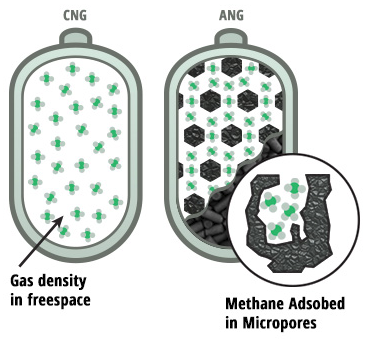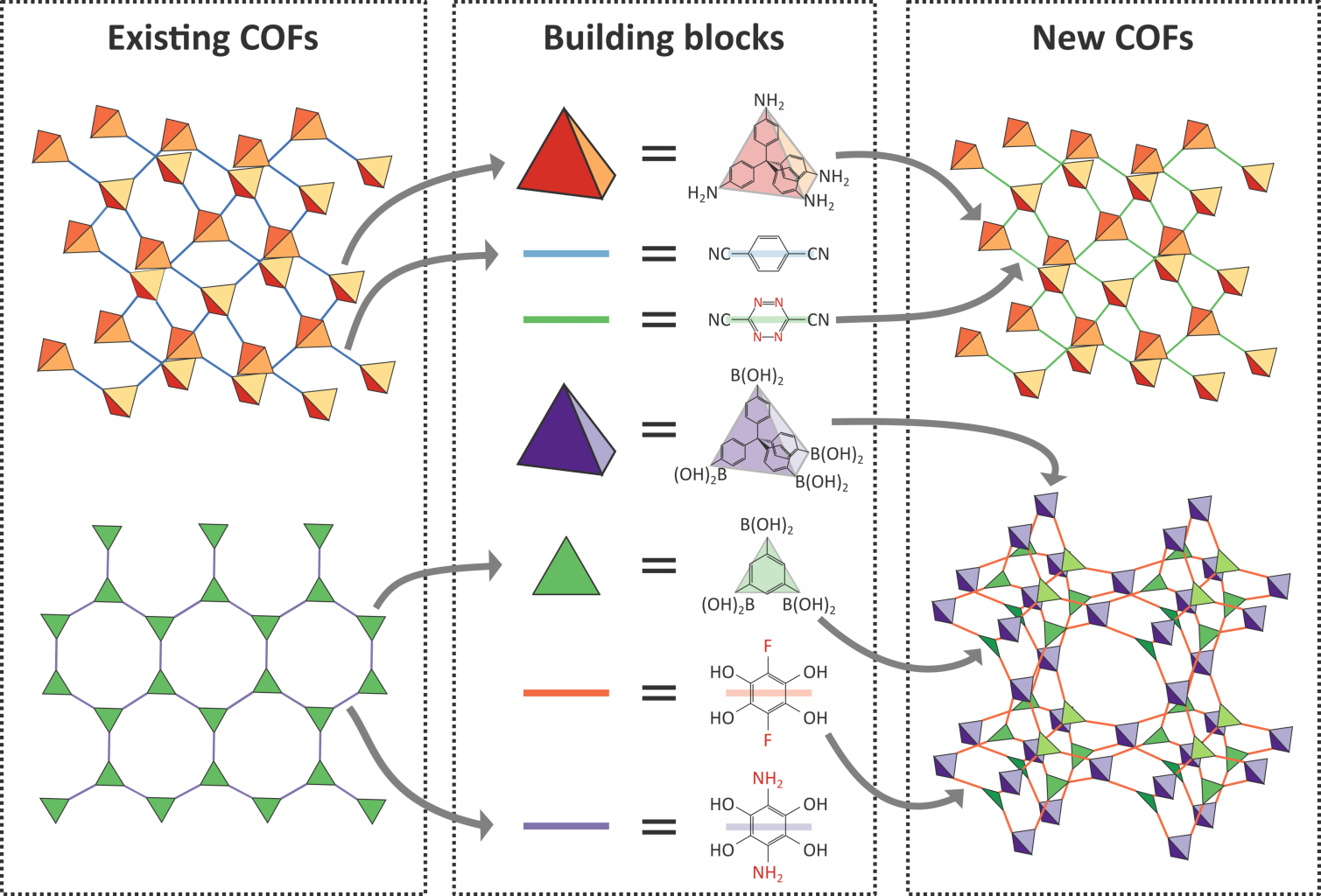Computationally designing guest-loaded covalent organic frameworks for next-generation fuel cells
Computationally designing guest-loaded covalent organic frameworks for next-generation fuel cells
Promotor(en): V. Van Speybroeck, S.M.J. Rogge /25630 / Nanoporous materialsBackground and problem
Natural gas and renewable natural gas form promising alternatives to conventional petroleum-based fuels for transportation because of their abundant reserves and lower carbon emissions. To efficiently store natural gas, which mainly consists of methane gas, one typically uses fuel cells that are filled with nanoporous materials such as covalent organic frameworks (COFs). Owing to the favorable interactions between the gas and the material’s large internal surface, the fuel tank can adsorb more natural gas in its pores than the empty vessel, resulting in a higher efficiency as illustrated in Figure 1 [1]. COFs are a very attractive filler materials, as their tunable building block structure allows for a rich variety in chemical and physical properties, and as they consist only of light-weight atoms that are held together by strong covalent bonds, resulting in a very low mass density and a high stability.

As the different building blocks in COFs can easily be extracted and recombined to generate yet-undiscovered COFs, an almost unlimited number of hypothetical COFs could in principle be synthesized, as indicated in Figure 2. Since the experimental characterization of these materials is time-consuming, it is not possible to investigate this large versatility of COFs experimentally. Instead, a computational screening is much more efficient. This computationally-aided design therefore has the potential to hugely accelerate the discovery of promising COF structures with an extraordinary natural gas uptake for application in fuel cells for, for instance, passenger vehicles [2]. In order to create COFs that can be implemented in industry, it is important to design materials that are sufficiently robust, so to withstand the thermal and mechanical stimuli to which the fuel tank is exposed during its lifecycle. By accurately optimizing critical parameters such as the thermal expansion, thermal conductivity, bulk modulus, and shear modulus during COF design, a sufficient thermal and mechanical stability will be ensured. Despite the fact that these parameters can be predicted through computer simulations, systematic knowledge on these physical properties for the relevant COFs and the influence of guests on these properties is still lacking [3].

Goal
To identify promising COFs for fuel cell applications, this thesis aims to accurately characterize the mechanical and thermal properties of a rich variety of guest-loaded COFs. To obtain the relevant adsorption, thermal and mechanical properties, various simulation techniques that will be taught during the thesis will be combined. These techniques will predominantly be based on Monte Carlo and molecular dynamics simulations or hybrid forms, considered in different ensembles [4]. To obtain accurate predictions of these properties, we will adopt in-house developed force fields fitted to quantum mechanical reference data [5]. The influence of the description of the interaction between the framework and the guest molecules on the various properties will have to be carefully evaluated.
The goal of the thesis is twofold. At first, we will benchmark our predictions on the well-known COF-5 and COF-102 for which abundant literature data is available. We will investigate the uptake capacity and the influence of adsorbed methane, ethane, nitrogen gas, and carbon dioxide – the main components of natural gas – on the thermal and mechanical properties of the framework. In a second step, we will tap the large database of COF structures and corresponding force fields that were recently developed at the CMM based on the procedure highlighted in Figure 2. This large database will be investigated in a high-throughput fashion to identify those COF structures harboring a vast potential to take up large amounts of natural gas. The proposed high-throughput screening will already filter out most hypothetical COFs that are unsuitable for fuel cells. Afterwards, the thermal and mechanical stability of the remaining structures will be investigated to ensure that they are sufficiently stable for industrial applications. Based on these insights, it is the aim to propose new pathways to tune the physical properties of COFs for fuel cell applications.
The student will be actively coached to make him/her acquainted with the advanced simulations techniques early in the thesis year, and to transfer necessary programming skills needed to perform the research.
- Study programmeMaster of Science in Engineering Physics [EMPHYS], Master of Science in Physics and Astronomy [CMFYST]KeywordsCovalent organic frameworks, fuel cells, mechanical properties, Thermal properties, gas adsorption, high-throughputReferences
[1] H. Furukawa and O. M. Yaghi, “Storage of Hydrogen, Methane, and Carbon Dioxide in Highly Porous Covalent Organic Frameworks for Clean Energy Applications,” J. Am. Chem. Soc., vol. 131, no. 25, pp. 8875-8883, 2009. [2] C. E. Wilmer, M. Leaf, C. Y. Lee, O. K. Farha, B. G. Hauser, J. T. Hupp and R. Q. Snurr, “Large-scale screening of hypothetical metal–organic frameworks,” Nat. Chem., vol. 4, pp. 83-89, 2012. [3] S. R. G. Balestra, R. Bueno-Perez, S. Hamad, D. Dubbeldam, A. R. Ruiz-Salvador and S. Calero, “Controlling Thermal Expansion: A Metal–Organic Frameworks Route,” Chem. Mater., vol. 28, no. 22, pp. 8296-8304, 2016. [4] S. M. J. Rogge, R. Goeminne, R. Demuynck, J. J. Gutiérrez-Sevillano, S. Vandenbrande, L. Vanduyfhuys, M. Waroquier, T. Verstraelen and V. Van Speybroeck, “Modeling Gas Adsorption in Flexible Metal–Organic Frameworks via Hybrid Monte Carlo/Molecular Dynamics Schemes,” Adv. Theory Simul., vol. 2, p. 1800177, 2019. [5] L. Vanduyfhuys, S. Vandenbrande, J. Wieme, M. Waroquier, T. Verstraelen and V. Van Speybroeck, “Extension of the QuickFF force field protocol for an improved accuracy of structural, vibrational, mechanical and thermal properties of metal–organic frameworks,” J. Comput. Chem., vol. 39, no. 16, pp. 999-1011, 2018.
